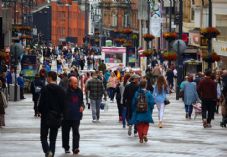UK DIY News
BRC: Black Friday Sales Boosted November Retail Spend

The BRC has reported on retail sales for November, covering the four weeks 31 October – 27 November 2021.
2020 was a turbulent year in which much of retail bounced between being open and closed, significantly impacting sales and changing consumer behaviours. In November 2020, retail entered a second lockdown, pushing many consumers to buy goods online. In this context, while all comparisons are provided on a year-on-year (YoY) basis, those focused on online/in-store have also been compared with November 2019 (Yo2Y). This will be clearly signposted below.
- On a Total basis, sales increased by 5.0% in November, against a growth of 0.9% in November 2020. This is above the 3-month average growth of 2.2% and the 12-month average growth of 9.9%.
- On a two-year basis, Total retail sales grew 4.1% (Yo2Y) during November compared with the same month in 2019.
- On a two-year basis, Total retail sales grew 4.1% (Yo2Y) during November compared with the same month in 2019.
- UK retail sales increased 1.8% on a Like-for-like basis from November 2020, when they had increased 7.7%. This was above the 3-month average growth of 0.2% and below the 12-month average growth of 9.3%.
- Over the three months to November, Food sales increased 0.1% on a Total basis and decreased 0.5% on a Like-for-like basis. This is below the 12-month Total average growth of 3.7%. For the single month of November, Food was in decline year-on-year.
- Over the three-months to November, Non-Food retail sales 3.9% on a Total basis and increased by 0.9% on a like-for-like basis. This is below the 12-month Total average growth of 15.1%. For the single month of November, Non-Food was in growth year-on-year.
- Over the three months to November, In-Store sales of Non-Food increased 30.5% on a Total basis and 22.2% on a Like-for-like basis. The Total growth was below the 12-month average of 34.0%.
- On a two-year comparison, over the three months to November, In-Store sales of Non-Food items declined 5.1% (Yo2Y) on a Total basis since November 2019. This is worse than the 2019 Total average decline of 3.1%.
- On a two-year comparison, over the three months to November, In-Store sales of Non-Food items declined 5.1% (Yo2Y) on a Total basis since November 2019. This is worse than the 2019 Total average decline of 3.1%.
- Online Non-Food sales decreased by 17.9% during November, compared to November 2020 when the UK was in lockdown. This is a decline from the 3-month decline of 10.8%.
- On a two-year comparison, Online Non-Food sales increased by 18.0% (Yo2Y) in November. This is below the 3-mth average increase of 23.4%.
- On a two-year comparison, Online Non-Food sales increased by 18.0% (Yo2Y) in November. This is below the 3-mth average increase of 23.4%.
- Non-Food Online penetration rate decreased to 47.5% in November from 71.0% in November 2020, during the second lockdown. However, it was up 10.4 percentage points on the 36.9% seen at the same point in 2019.
Helen Dickinson OBE, Chief Executive | British Retail Consortium
“While Christmas may or may not be getting earlier every year, Black Friday certainly is. The American holiday has now become a month-long affair in the UK, with deals spread over a longer period than ever before. As people prepared their wardrobes for the cold weather this winter, consumers took advantage of discounted clothing, shifting the focus of Black Friday from just electronics and household appliances. While e-commerce was significantly down on last year, when lockdown pushed more consumers online, it still remains almost one-fifth up on pre-pandemic levels, accounting for almost half of all Non-Food spend.
“Looking forward to Christmas, spending patterns suggest that sales could be more spread out than in previous years. Consumers, erring on the side of caution, are shopping for gifts earlier to get ahead of issues relating to shipping and transport. Meanwhile, retailers are doing everything they can to prepare stores, warehouses and deliveries ahead of Christmas, prioritising all the food and gifts that customers will need to enjoy the festive season.”
Paul Martin, UK Head of Retail | KPMG
“Consumers determined to enjoy Christmas hit the high street in November with sales up 5% compared to last year. Apparel and jewellery dominated Christmas gift buying at the tills, whilst limited Black Friday promotions saw big purchases for the home and on technology put on hold as sales continued to fall in these categories.
“The high street dominated sales growth during November as consumers buoyed by the continued roll out of the vaccine programme, and eager to ensure they secured the gifts they want for Christmas, headed for physical stores to do their festive shopping. Online sales fell yet again in November, with only clothing sales seeing minor positive growth.
“Retailers will be hoping consumer confidence continues this month, while keeping close to Government COVID-19 updates, as we head to the vital few shopping weeks before Christmas. As we look ahead to the new year, rising costs continue to bite into margins and supply chain issues have impacted the availability of goods, leaving retailers with very little room for the mega discounting events we have seen in previous January sales. Rising inflation which could top 4% + by the end of this year, is likely to prompt an interest rate rise sooner rather than later, which could dent consumer confidence and spending.”
Food & Drink sector performance | Susan Barratt, CEO | IGD
“Food and drinks sales in November struggled to compete with the same period in 2020 when sales soared as we entered the second national lockdown. However, activity did pick up in the second half of the month as shoppers started to ramp up spending in preparation for Christmas and the festive period.
“With 61% of shoppers looking forward to getting back to traditional Christmas celebrations, IGD’s Shopper Confidence Index improved slightly in November. And while over two-thirds (67%) of shoppers think Christmas is a time to splash out on food, more are setting a budget on their Christmas food shopping (31% compared to 26% in ’20) as we see the rising cost of living starting to take hold. Our ShopperVista research also reveals that 29% of shoppers now expect food to get much more expensive in the year ahead, the highest level recorded, with increasing numbers claiming to already be experiencing rising food and energy bills.”
Source : BRC
Insight DIY is the only source of market information that I need and they always have the latest news before anyone else.











































